+ Open data
Open data
- Basic information
Basic information
| Entry | Database: PDB / ID: 7n1i | |||||||||||||||||||||||||||||||||||||||||||||||||||||||||||||||||||||||||||||||||
|---|---|---|---|---|---|---|---|---|---|---|---|---|---|---|---|---|---|---|---|---|---|---|---|---|---|---|---|---|---|---|---|---|---|---|---|---|---|---|---|---|---|---|---|---|---|---|---|---|---|---|---|---|---|---|---|---|---|---|---|---|---|---|---|---|---|---|---|---|---|---|---|---|---|---|---|---|---|---|---|---|---|---|
| Title | CryoEM structure of Venezuelan equine encephalitis virus VLP | |||||||||||||||||||||||||||||||||||||||||||||||||||||||||||||||||||||||||||||||||
 Components Components |
| |||||||||||||||||||||||||||||||||||||||||||||||||||||||||||||||||||||||||||||||||
 Keywords Keywords | VIRUS LIKE PARTICLE / viral envelope / encephalitic alphavirus / VLP / Structural Genomics / Center for Structural Genomics of Infectious Diseases / CSGID / VEEV | |||||||||||||||||||||||||||||||||||||||||||||||||||||||||||||||||||||||||||||||||
| Function / homology |  Function and homology information Function and homology informationT=4 icosahedral viral capsid / host cell cytoplasm / serine-type endopeptidase activity / fusion of virus membrane with host endosome membrane / symbiont entry into host cell / virion attachment to host cell / host cell nucleus / host cell plasma membrane / virion membrane / structural molecule activity ...T=4 icosahedral viral capsid / host cell cytoplasm / serine-type endopeptidase activity / fusion of virus membrane with host endosome membrane / symbiont entry into host cell / virion attachment to host cell / host cell nucleus / host cell plasma membrane / virion membrane / structural molecule activity / proteolysis / RNA binding / membrane Similarity search - Function | |||||||||||||||||||||||||||||||||||||||||||||||||||||||||||||||||||||||||||||||||
| Biological species |  Venezuelan equine encephalitis virus Venezuelan equine encephalitis virus | |||||||||||||||||||||||||||||||||||||||||||||||||||||||||||||||||||||||||||||||||
| Method | ELECTRON MICROSCOPY / single particle reconstruction / cryo EM / Resolution: 4.2 Å | |||||||||||||||||||||||||||||||||||||||||||||||||||||||||||||||||||||||||||||||||
 Authors Authors | Basore, K. / Nelson, C.A. / Fremont, D.H. / Center for Structural Genomics of Infectious Diseases (CSGID) | |||||||||||||||||||||||||||||||||||||||||||||||||||||||||||||||||||||||||||||||||
| Funding support |  United States, 1items United States, 1items
| |||||||||||||||||||||||||||||||||||||||||||||||||||||||||||||||||||||||||||||||||
 Citation Citation |  Journal: Nature / Year: 2021 Journal: Nature / Year: 2021Title: Structure of Venezuelan equine encephalitis virus in complex with the LDLRAD3 receptor. Authors: Katherine Basore / Hongming Ma / Natasha M Kafai / Samantha Mackin / Arthur S Kim / Christopher A Nelson / Michael S Diamond / Daved H Fremont /  Abstract: LDLRAD3 is a recently defined attachment and entry receptor for Venezuelan equine encephalitis virus (VEEV), a New World alphavirus that causes severe neurological disease in humans. Here we present ...LDLRAD3 is a recently defined attachment and entry receptor for Venezuelan equine encephalitis virus (VEEV), a New World alphavirus that causes severe neurological disease in humans. Here we present near-atomic-resolution cryo-electron microscopy reconstructions of VEEV virus-like particles alone and in a complex with the ectodomains of LDLRAD3. Domain 1 of LDLRAD3 is a low-density lipoprotein receptor type-A module that binds to VEEV by wedging into a cleft created by two adjacent E2-E1 heterodimers in one trimeric spike, and engages domains A and B of E2 and the fusion loop in E1. Atomic modelling of this interface is supported by mutagenesis and anti-VEEV antibody binding competition assays. Notably, VEEV engages LDLRAD3 in a manner that is similar to the way that arthritogenic alphaviruses bind to the structurally unrelated MXRA8 receptor, but with a much smaller interface. These studies further elucidate the structural basis of alphavirus-receptor interactions, which could inform the development of therapies to mitigate infection and disease against multiple members of this family. | |||||||||||||||||||||||||||||||||||||||||||||||||||||||||||||||||||||||||||||||||
| History |
|
- Structure visualization
Structure visualization
| Movie |
 Movie viewer Movie viewer |
|---|---|
| Structure viewer | Molecule:  Molmil Molmil Jmol/JSmol Jmol/JSmol |
- Downloads & links
Downloads & links
- Download
Download
| PDBx/mmCIF format |  7n1i.cif.gz 7n1i.cif.gz | 705.2 KB | Display |  PDBx/mmCIF format PDBx/mmCIF format |
|---|---|---|---|---|
| PDB format |  pdb7n1i.ent.gz pdb7n1i.ent.gz | Display |  PDB format PDB format | |
| PDBx/mmJSON format |  7n1i.json.gz 7n1i.json.gz | Tree view |  PDBx/mmJSON format PDBx/mmJSON format | |
| Others |  Other downloads Other downloads |
-Validation report
| Summary document |  7n1i_validation.pdf.gz 7n1i_validation.pdf.gz | 1.8 MB | Display |  wwPDB validaton report wwPDB validaton report |
|---|---|---|---|---|
| Full document |  7n1i_full_validation.pdf.gz 7n1i_full_validation.pdf.gz | 1.8 MB | Display | |
| Data in XML |  7n1i_validation.xml.gz 7n1i_validation.xml.gz | 134.6 KB | Display | |
| Data in CIF |  7n1i_validation.cif.gz 7n1i_validation.cif.gz | 198.4 KB | Display | |
| Arichive directory |  https://data.pdbj.org/pub/pdb/validation_reports/n1/7n1i https://data.pdbj.org/pub/pdb/validation_reports/n1/7n1i ftp://data.pdbj.org/pub/pdb/validation_reports/n1/7n1i ftp://data.pdbj.org/pub/pdb/validation_reports/n1/7n1i | HTTPS FTP |
-Related structure data
| Related structure data |  24117MC  7n1hC M: map data used to model this data C: citing same article ( |
|---|---|
| Similar structure data | |
| Other databases |
- Links
Links
- Assembly
Assembly
| Deposited unit | 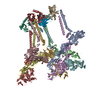
|
|---|---|
| 1 | x 60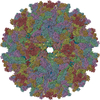
|
| 2 |
|
| 3 | x 5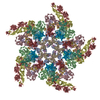
|
| 4 | x 6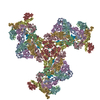
|
| 5 | 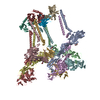
|
| Symmetry | Point symmetry: (Schoenflies symbol: I (icosahedral)) |
- Components
Components
| #1: Protein | Mass: 47952.066 Da / Num. of mol.: 4 Source method: isolated from a genetically manipulated source Source: (gene. exp.)  Venezuelan equine encephalitis virus / Cell line (production host): HEK293F / Production host: Venezuelan equine encephalitis virus / Cell line (production host): HEK293F / Production host:  Homo sapiens (human) / References: UniProt: A0A0C4MX98 Homo sapiens (human) / References: UniProt: A0A0C4MX98#2: Protein | Mass: 47113.746 Da / Num. of mol.: 4 Source method: isolated from a genetically manipulated source Source: (gene. exp.)  Venezuelan equine encephalitis virus / Cell line (production host): HEK293F / Production host: Venezuelan equine encephalitis virus / Cell line (production host): HEK293F / Production host:  Homo sapiens (human) / References: UniProt: A0A0C4MX98 Homo sapiens (human) / References: UniProt: A0A0C4MX98#3: Protein | Mass: 18195.840 Da / Num. of mol.: 4 Source method: isolated from a genetically manipulated source Source: (gene. exp.)  Venezuelan equine encephalitis virus / Cell line (production host): HEK293F / Production host: Venezuelan equine encephalitis virus / Cell line (production host): HEK293F / Production host:  Homo sapiens (human) / References: UniProt: A0A0C4MX98 Homo sapiens (human) / References: UniProt: A0A0C4MX98#4: Sugar | ChemComp-NAG / Has ligand of interest | N | Has protein modification | Y | |
|---|
-Experimental details
-Experiment
| Experiment | Method: ELECTRON MICROSCOPY |
|---|---|
| EM experiment | Aggregation state: PARTICLE / 3D reconstruction method: single particle reconstruction |
- Sample preparation
Sample preparation
| Component | Name: Venezuelan equine encephalitis virus / Type: VIRUS Details: Virus like particle produce in HEK293F cells by recombinant expression of structural proteins. Entity ID: #1-#3 / Source: RECOMBINANT |
|---|---|
| Source (natural) | Organism:  Venezuelan equine encephalitis virus / Strain: TC-83 Venezuelan equine encephalitis virus / Strain: TC-83 |
| Source (recombinant) | Organism:  Homo sapiens (human) / Cell: HEK293F Homo sapiens (human) / Cell: HEK293F |
| Details of virus | Empty: YES / Enveloped: YES / Isolate: STRAIN / Type: VIRUS-LIKE PARTICLE |
| Natural host | Organism: Mosquito |
| Buffer solution | pH: 7.4 |
| Specimen | Embedding applied: NO / Shadowing applied: NO / Staining applied: NO / Vitrification applied: YES |
| Vitrification | Cryogen name: ETHANE |
- Electron microscopy imaging
Electron microscopy imaging
| Experimental equipment |  Model: Titan Krios / Image courtesy: FEI Company |
|---|---|
| Microscopy | Model: FEI TITAN KRIOS |
| Electron gun | Electron source:  FIELD EMISSION GUN / Accelerating voltage: 300 kV / Illumination mode: SPOT SCAN FIELD EMISSION GUN / Accelerating voltage: 300 kV / Illumination mode: SPOT SCAN |
| Electron lens | Mode: BRIGHT FIELD |
| Image recording | Electron dose: 35 e/Å2 / Film or detector model: GATAN K2 SUMMIT (4k x 4k) |
- Processing
Processing
| Software |
| ||||||||||||||||||||||||
|---|---|---|---|---|---|---|---|---|---|---|---|---|---|---|---|---|---|---|---|---|---|---|---|---|---|
| EM software |
| ||||||||||||||||||||||||
| CTF correction | Type: PHASE FLIPPING ONLY | ||||||||||||||||||||||||
| Particle selection | Num. of particles selected: 19516 | ||||||||||||||||||||||||
| Symmetry | Point symmetry: I (icosahedral) | ||||||||||||||||||||||||
| 3D reconstruction | Resolution: 4.2 Å / Resolution method: FSC 0.143 CUT-OFF / Num. of particles: 7993 / Symmetry type: POINT | ||||||||||||||||||||||||
| Refinement | Cross valid method: THROUGHOUT | ||||||||||||||||||||||||
| Displacement parameters | Biso max: 232.72 Å2 / Biso mean: 123.397 Å2 / Biso min: 68.16 Å2 | ||||||||||||||||||||||||
| Refine LS restraints |
|
 Movie
Movie Controller
Controller





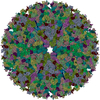
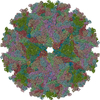
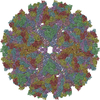
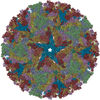
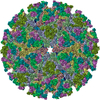

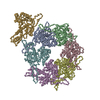
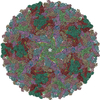
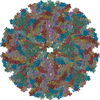
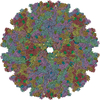
 PDBj
PDBj




